What's Happening Here?
I can't think of a better way of starting the newsletter and heading into the holiday weekend than with a good diagnostic challenge. Happy Turkey Day, by the way! Take a look at this image of roses:
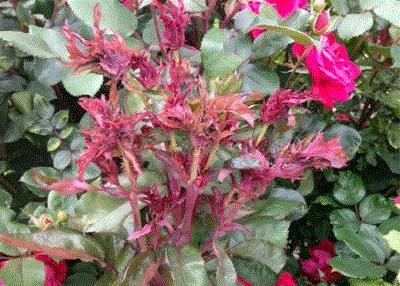
If you're a nurseryman, you've likely heard of or even seen this issue firsthand. If you're more in the greenhouse side of the business, you may have heard about it, but likely have never seen it in person. I suspect this challenge will be super easy for some, while a bit more difficult for others. Unfortunately, there's no further clues on this one. Therefore, it's time for me to ask, "What's happening here?" Good luck—I'll let you know the answer at the end of the newsletter.
Marengo Guidelines Released
Bayer Environmental Science just released a new technical sheet to help growers succeed with its highly popular and effective pre-emergence herbicide, Marengo. The new bulletin titled, “Best Management Practices for Applying Marengo in Enclosed Structures,” provides numerous helpful guidelines to provide safe applications within enclosed structures.
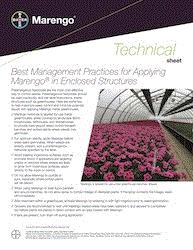
Here are some of the highlights I gleaned from the tech sheet:
-
Being a pre-emergence herbicide, Marengo must be applied before weed seeds germinate. However, if weeds are present, it can be tank-mixed with certain post-emergence herbicides.
-
It’s intended for applications to bare ground—avoid treating impervious surfaces such as concrete floors. Applications can be made to cracks and crevices where weed seeds germinate, but avoid applying over the entire impervious surface.
-
Avoid applying Marengo to low spots where puddling or pooling of water occurs. This is especially important in locations where containerized plants will be growing.
-
Similar to all other pre-emergence applications, it’s recommended to activate the Marengo by watering it in following the application. Allow the area to dry completely before setting crops down on the treated area.
Click here to learn more about these and other helpful guidelines by reading this Marengo tech sheet (consider downloading it for future reference).

Farm Workforce Modernization Act
In the last newsletter, I discussed the progress that's been made with the Farm Workforce Modernization Act.
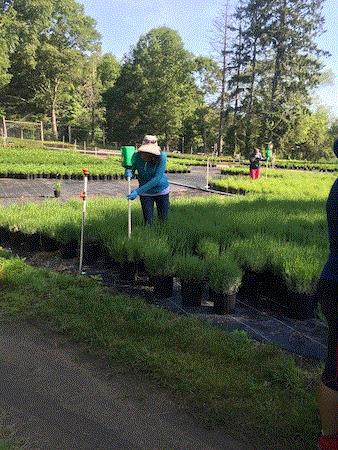
This act has some pretty important implications to our industry. Among the changes this bill makes, it would:
-
Provide pathways to legal status for experienced and contributing agricultural workers, with strong incentives to continue working in agriculture
-
Streamline the H-2A program for agricultural employers, providing some wage and cost relief, and certainty
-
Phase in use of the E-Verify system across the agriculture sector, after stabilizing reforms are in place
As you can see from these highlights, the bill goes a long way towards addressing the labor crisis our agricultural and horticultural businesses face here in the U.S. Click here if you're not up to speed or are interested in reading more about this important piece of legislation.
Last week, the bill was reviewed by the House Judiciary Committee and has been sent to the House of Representatives for consideration. This is where we need your help. Please take the time to ask your House Representative to support the new Farm Workforce Modernization Act. You can easily do this by filling out a quick form.
Click this link to fill out the form letting your Representative know that you support this bill.

Georgia Peach Pie
Perhaps I'm thinking too much about all the good food I'll be consuming during this holiday weekend. One thing I really enjoy during the holiday is a good slice of pie. Well, that made me think of how much I also enjoy Dianthus Georgia Peach Pie.
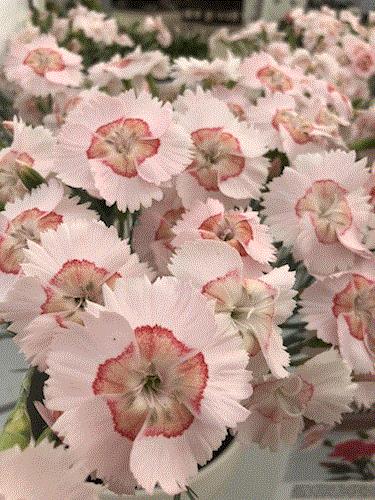
Georgia Peach Pie is one of three cultivars in the American Pie series of Dianthus from PlantHaven. This cultivar is a recent pink introduction described as having delicate, pale-bluish pink petals surrounding vibrant coral centers. This prolific bloomer holds its flowers atop sturdy stems that don't flop. It's fragrant, reblooms and is cold hardy to Zone 5.
The Answer is ...
At the top of the newsletter, I shared the image of the roses below. Were you able to figure out what's causing the deformed growth?
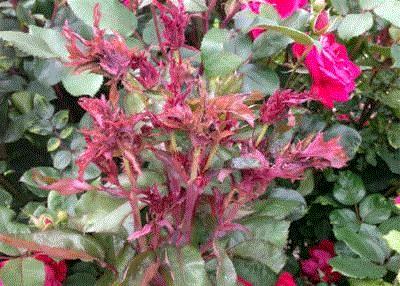
This sure doesn't look normal to me. What have you come up with? Rhodococcus, hormone imbalance, witch’s broom/aster yellows, herbicide damage? Perhaps you answered Rose Rosette Disease. If that was your final answer, you successfully diagnosed the problem. But what exactly is Rose Rosette Disease?

These photos are courtesy of Jennifer Olson, Oklahoma State University. I found them in a great article titled, "What is Rose Rosette Disease?" on the Proven Winners website. Click here to read it.
Rose Rosette Disease (RRD) isn't your typical disease caused by bacterial or fungal pathogens—RRD is caused by a virus. It's not uncommon for there to be no symptoms early in the disease cycle. The first symptoms can be rather subtle and often resemble those caused by nutrient deficiencies or herbicide injury. In some cases, the canes may be slightly thickened or the flowers will contain fewer-than-normal petals. These early symptoms are often dismissed or not recognized as RRD.
Later in the disease cycle, the symptoms become very overt and obvious. Severely infected plants often have rapid elongation of the new shoots, red pigmentation of the stems or foliage, small or distorted leaves, produce an excessive amount of thorns, or develop tiny, tight clusters of flower buds (these are the “rosettes” that gave the disease its name). Infected plants may express only one of these symptoms or all of them. By the time these symptoms appear, it's likely that adjacent roses have also been infected.
The virus is vectored by Eriophyid mites, which are so small they can only be seen under strong magnification. Although, these tiny mites vector the virus, the mites are easily moved from plant to plant by wind, animals and pruning tools.
Unfortunately, there's no cure for RRD. Infected plants should be discarded. Trimming out the infected parts of the plant will not remove the virus; always throw away the entire plant when the symptoms are confirmed to be caused by RRD. The best method for preventing RRD is to regularly apply miticides that are effective at controlling the Eriophyid mites. Rotating between miticides containing abamectin, etoxazole and fenpyroximate can be effective at reducing Eriophyid mite populations (miticides should be applied before the mite populations get high).

A New Diagnostic Tool
Early detection of RRD has been challenging since the roses can be infected, but it can take weeks or months for symptoms to appear. In the meantime, while the plants are asymptomatic, the virus can spread throughout a landscape or production site. Viruses are too small to see with the naked eye, causing growers and diagnosticians to send samples to a lab where serological and/or molecular techniques can be conducted to confirm and identify a virus is present in the plant tissue.
Matthew Chappell, Editor-at-Large for Ball Publishing's Nursery & Landscape Insider newsletter, discussed a new diagnostic tool developed to detect RRD in his newsletter this week. Check it out:
A research team led by Texas A&M University has been working since 2014 on various aspects of RRD through a multi-year, multi-million dollar grant titled "Combatting Rose Rosette Disease" funded by the U.S. Department of Agriculture and development of diagnostics has been a key component. Knowing sooner that a plant is infected will, in the very least, help limit spread and movement of the disease.
A small team of researchers (part of the larger group mentioned above) led by Dr. Dmitry Kurouski has actually been successful in developing a new diagnostic tool for RRD detection. Using a hand-held, portable Raman spectrometer, Dr. Kurouski’s team has correctly identified the virus in leaves, both non-invasively and non-destructively, with an almost instant read.
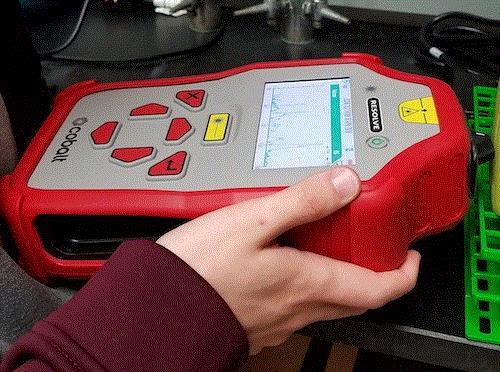
This handy-dandy spectrometer is being used to detect Rose Rosette Disease in asymptomatic plants and could change the game in virus scouting and identification.
Raman spectroscopy works by relying on light to interact with molecular vibrations in a leaf. A "fingerprint" is made based on these vibrations, meaning that the virus that causes RRD is identified by its unique fingerprint. Previously, the team proved that this technology could identify fungal diseases on corn, wheat and sorghum, and eventually adapted it to successfully compare healthy and asymptomatic rose leaves. They could even differentiate rose leaves with different degrees of infection.
While not yet ready for widespread adoption and use in the industry, this tool can help diagnostic labs by acting as an initial screen for RRD that can help save on more costly, molecular techniques. Plus, it may be available for use in the field one day!
The American Rose Society provided small research grants for a portion of this work. AmericanHort and its Horticultural Research Institute affiliate, in conjunction with like-minded organizations such as the Society of American Florists, previously supported Rose Rosette research that initially got this project moving in the right direction.
Thank you, Matthew, for this great update.




Thanks for reading this edition of Perennial Pulse. Please let me know if you have any questions or article ideas for future newsletters.
My email is ppilon@ballpublishing.com.
Take care,
Paul Pilon
Editor-at-Large
Perennial Pulse
This email was received by you and over 30,383 subscribers!
If you're interested in advertising in Perennial Pulse, contact Kim Brown ASAP and she'll hook you up.